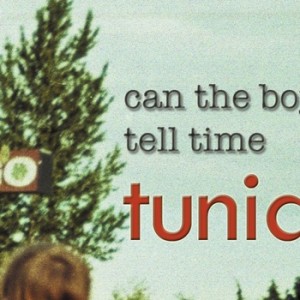 Can the Boy Tell Time – Tunia
Can the Boy Tell Time – Tunia
(2011, self-released)
Tunia is the kindly face-melting new album from Seattle band Can The Boy Tell Time. This music is by no means easy to describe, but I am eager to try. But before I get into it, I want to point out: CTBTT is having their release show for Tunia this Friday, 7/1, at The Mars Bar, with a new 4-piece lineup. I highly encourage you to join me there; it should be quite a treat.
CTBTT is the project of Peter Verdoes and various collaborators. Tunia is the follow-up to their debut full-length The Llama Tapes. Verdoes is well-regarded for a former project as well, math-rock group In Praise Of Folly. He says CTBTT “sort of started in reaction to the pompous nature of my old previous band and the complexity of it all (math rock stuff, touring with a string section, etc). I just wanted to keep everything simple and fairly minimal this time around.” To that end Peter mostly recorded Tunia himself, at home, on old 4-track cassette and 16-track Fostex decks. Translation: this means creative limitation, and you can hear it; the record sounds like real people playing full takes.
As far as collaborators, according to Peter this album includes “(former drummer) Shannon Barry handling most of the drums and keys. Matthew Dammer (Mt. St. Helens Vietnam Band, In Praise of Folly) added some synths and horns, Johnny Warman (Fences) did some of the bass and Hilary Bryant (In Praise of Folly) did the violin.” As for the recording/post process, “some editing was done with Scott Colburn (Arcade Fire, Animal Collective, etc.) at his studio and then vocals, additional overdubs and mixing were done with Johnny Warman at his Zoo Loft studio at the old OK Hotel.”
This is not easy-listening, which I find refreshing given a lot of the recent music vying for my ears. The lo-fi, DIY (figured those words had to show up sooner or later) nature of the record leaves you wanting more, straining to hear around the spikes to the auto-harp and its mysterious companions. Drums throughout are over-cooked (in a good way), often past crunchy to a silken sheen. Jagged chunks of sound fit together like half-assembled jigsaw pieces, then give way to warm beds of layered sound.
http://www.youtube.com/watch?v=dggqDvaHbYw
Now, how about a breakneck tour before I leave you?
The above video accompanies the first track on the album, “Thirty-Two,” which has noisy driving layers of guitar, piano, drums, keys, all unfolding like sheets of acid rain, in the midst of which are vocals buried in a way that reminds me of old Sonic Youth or early Blonde Redhead. “Stadia” settles down a bit, with strummed guitar layers and simple, lilting drums carrying along the verses, to be joined later by a lovely horn arrangement. These two are followed by several more tracks that will alternately tear your face off or melt your soul.
It is difficult for me to make out most of the lyrics on the album, partly because many of them are couched within or buried beneath a wealth of sonic action, and partly because I am bad at listening for lyrics. But I like to imagine Tunia as a series of mental snapshots, washed-out Polaroids, bent and scratched, the flames of faded memories. If so, the penultimate track, “1971,” is one last look back at times of friendships and summer pool parties, and “‘72,” the instrumental reprise that directly follows it, is the dancing, drowning reflection in the sparkling water.
I’d like to mention as well a bandcamp page for further listening or purchase (name your price!). The lineup this Friday will be Peter Verdoes on vocals/guitar, Nate Stout on drums, Nick Merz on guitar and Jessica Gore on bass/keys. I hope to see you there!

go Peter go.